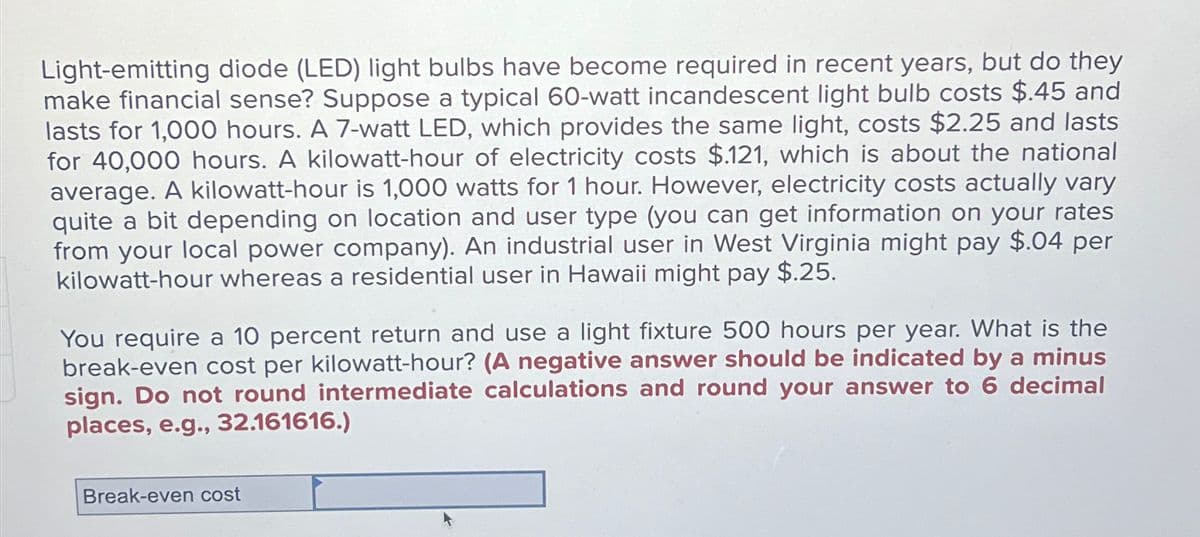Light-emitting diode (LED) light bulbs have become required in recent years, but do they make financial sense? Suppose a typical 60-watt incandescent light bulb costs $.45 and lasts for 1,000 hours. A 7-watt LED, which provides the same light, costs $2.25 and lasts for 40,000 hours. A kilowatt-hour of electricity costs $.121, which is about the national average. A kilowatt-hour is 1,000 watts for 1 hour. However, electricity costs actually vary quite a bit depending on location and user type (you can get information on your rates from your local power company). An industrial user in West Virginia might pay $.04 per kilowatt-hour whereas a residential user in Hawaii might pay $.25. You require a 10 percent return and use a light fixture 500 hours per year. What is the break-even cost per kilowatt-hour? (A negative answer should be indicated by a minus sign. Do not round intermediate calculations and round your answer to 6 decimal places, e.g., 32.161616.) Break-even cost
Light-emitting diode (LED) light bulbs have become required in recent years, but do they make financial sense? Suppose a typical 60-watt incandescent light bulb costs $.45 and lasts for 1,000 hours. A 7-watt LED, which provides the same light, costs $2.25 and lasts for 40,000 hours. A kilowatt-hour of electricity costs $.121, which is about the national average. A kilowatt-hour is 1,000 watts for 1 hour. However, electricity costs actually vary quite a bit depending on location and user type (you can get information on your rates from your local power company). An industrial user in West Virginia might pay $.04 per kilowatt-hour whereas a residential user in Hawaii might pay $.25. You require a 10 percent return and use a light fixture 500 hours per year. What is the break-even cost per kilowatt-hour? (A negative answer should be indicated by a minus sign. Do not round intermediate calculations and round your answer to 6 decimal places, e.g., 32.161616.) Break-even cost
Chapter10: Short-term Decision Making
Section: Chapter Questions
Problem 2PA: Syntech makes digital cameras for drones. Their basic digital camera uses $80 in variable costs and...
Related questions
Question
i dont want thand writting image otherwise i will deslike you in 10 account

Transcribed Image Text:Light-emitting diode (LED) light bulbs have become required in recent years, but do they
make financial sense? Suppose a typical 60-watt incandescent light bulb costs $.45 and
lasts for 1,000 hours. A 7-watt LED, which provides the same light, costs $2.25 and lasts
for 40,000 hours. A kilowatt-hour of electricity costs $.121, which is about the national
average. A kilowatt-hour is 1,000 watts for 1 hour. However, electricity costs actually vary
quite a bit depending on location and user type (you can get information on your rates
from your local power company). An industrial user in West Virginia might pay $.04 per
kilowatt-hour whereas a residential user in Hawaii might pay $.25.
You require a 10 percent return and use a light fixture 500 hours per year. What is the
break-even cost per kilowatt-hour? (A negative answer should be indicated by a minus
sign. Do not round intermediate calculations and round your answer to 6 decimal
places, e.g., 32.161616.)
Break-even cost
AI-Generated Solution
Unlock instant AI solutions
Tap the button
to generate a solution
Recommended textbooks for you

Principles of Accounting Volume 2
Accounting
ISBN:
9781947172609
Author:
OpenStax
Publisher:
OpenStax College

EBK CONTEMPORARY FINANCIAL MANAGEMENT
Finance
ISBN:
9781337514835
Author:
MOYER
Publisher:
CENGAGE LEARNING - CONSIGNMENT

Principles of Accounting Volume 2
Accounting
ISBN:
9781947172609
Author:
OpenStax
Publisher:
OpenStax College

EBK CONTEMPORARY FINANCIAL MANAGEMENT
Finance
ISBN:
9781337514835
Author:
MOYER
Publisher:
CENGAGE LEARNING - CONSIGNMENT